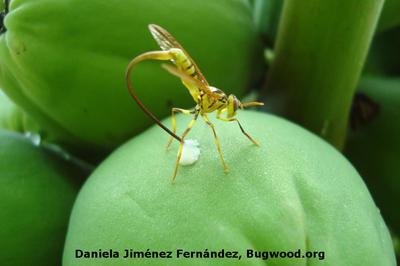Papaya Fruit Fly
Toxotrypana curvicauda
Insect
In a Nutshell
- Punctured fruit skin.
- Yellowing of fruit.
- Premature fruit drop.
Can also be found in
Symptoms
Females lay several eggs into very young or young fruits. The punctured skin exudes drops of white latex. The larvae hatch and dig tunnels through the pulp to reach the seed cavity and feed on the developing seeds. Exit holes are clearly visible on the fruit surface. The extensive tunnelling results in rotting of the flesh, reflected as brown and sometimes black lesions as it progressively decays. Fruits subsequently give off a foul odor and may ooze a juice-like substance. The skin turns yellow and may appear scabbed or pitted. The fruits ripen and can drop off prematurely.
Recommendations

Organic Control
The parasitic wasp Doryctobracon toxotrypanae may have potential for control.

Chemical Control
Always consider an integrated approach with preventive measures together with biological treatments if available. No insecticide seems to be effective against this fly. Traps containing an insecticide (e.g. malathion or deltamethrin) combined with a specific bait (for males or females) are being tested. Fruits can be treated with hot vapors of insecticides to kill the papaya fruit fly.
What caused it?
The symptoms are caused by the fly Toxotrypana curvicauda that lays its eggs into small green papaya fruits. Adults are commonly mistaken for wasps because of their size, color, and behavior. They have a yellowish body with black marks symmetrically placed on the thorax. Females have a long, narrow abdomen with a extended curved egg-laying organ that exceeds the length of the body. Larvae are white and slender, about 13-15 mm in length. Fruits may be infested with several larvae each and show symptoms post-harvest. Fruit damage is highest after the rainy season is over. The papaya fruit fly is a major pest in the the tropical and subtropical areas of the American continent.
Preventive Measures
- Monitor the damage or install pheromone traps to monitor fly population.
- Use paper bags to cover the fruits and hinder the laying of eggs (bagging).
- Rid the field of dropped and prematurely ripe fruit.
- Pick infested young fruits and destroy them.
- Use trap crops around the field to attract the flies.
- Harvest earlier to avoid the worst damage.
- Store fruits at temperatures between 13 and 16°C.
- Tilling around the trees kills the ground-developing adults before emergence.



